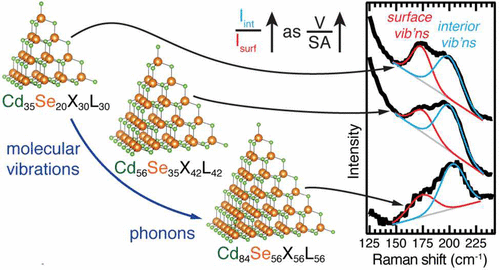当前位置:
X-MOL 学术
›
J. Am. Chem. Soc.
›
论文详情
Our official English website, www.x-mol.net, welcomes your
feedback! (Note: you will need to create a separate account there.)
Transition from Molecular Vibrations to Phonons in Atomically Precise Cadmium Selenide Quantum Dots
Journal of the American Chemical Society ( IF 14.4 ) Pub Date : 2016-12-16 , DOI: 10.1021/jacs.6b10705 Alexander N. Beecher 1 , Rachel A. Dziatko 2 , Michael L. Steigerwald 1 , Jonathan S. Owen 1 , Andrew C. Crowther 2
Journal of the American Chemical Society ( IF 14.4 ) Pub Date : 2016-12-16 , DOI: 10.1021/jacs.6b10705 Alexander N. Beecher 1 , Rachel A. Dziatko 2 , Michael L. Steigerwald 1 , Jonathan S. Owen 1 , Andrew C. Crowther 2
Affiliation

|
We use micro-Raman spectroscopy to measure the vibrational structure of the atomically precise cadmium selenide quantum dots Cd35Se20X30L30, Cd56Se35X42L42, and Cd84Se56X56L56. These quantum dots have benzoate (X) and n-butylamine (L) ligands and tetrahedral (Td) shape with edges that range from 1.7 to 2.6 nm in length. Investigating this previously unexplored size regime allows us to identify the transition from molecular vibrations to bulk phonons in cadmium selenide quantum dots for the first time. Room-temperature Raman spectra have broad CdSe peaks at 175 and 200 cm-1. Density functional theory calculations assign these peaks to molecular surface and interior vibrational modes, respectively, and show that the interior, surface, and ligand atom motion is strongly coupled. The interior peak intensity increases relative to the surface peak as the cluster size increases due to the relative increase in the polarizability of interior modes with quantum dot size. The Raman spectra do not change with temperature for molecular Cd35Se20X30L30, while the interior peak narrows and shifts to higher energy as temperature decreases for Cd84Se56X56L56, a spectral evolution typical of a phonon. This result shows that the single bulk unit cell contained within Cd84Se56X56L56 is sufficient to apply a phonon confinement model, and that Cd56Se35X42L42, with its 2.1 nm edge length, marks the boundary between molecular vibrations and phonons.
中文翻译:

在原子精确的硒化镉量子点中从分子振动到声子的转变
我们使用微拉曼光谱测量原子级精确硒化镉量子点 Cd35Se20X30L30、Cd56Se35X42L42 和 Cd84Se56X56L56 的振动结构。这些量子点具有苯甲酸盐 (X) 和正丁胺 (L) 配体以及四面体 (Td) 形状,边缘长度范围为 1.7 至 2.6 nm。研究这种以前未探索过的尺寸范围使我们能够首次确定硒化镉量子点中从分子振动到体声子的转变。室温拉曼光谱在 175 和 200 cm-1 处有宽的 CdSe 峰。密度泛函理论计算将这些峰分别分配给分子表面和内部振动模式,并表明内部、表面和配体原子运动是强耦合的。由于内部模式的极化率随量子点尺寸的相对增加,内部峰强度相对于表面峰随着簇尺寸的增加而增加。分子 Cd35Se20X30L30 的拉曼光谱不随温度变化,而随着温度降低,Cd84Se56X56L56 的内部峰变窄并转移到更高的能量,这是声子的典型光谱演变。该结果表明,包含在 Cd84Se56X56L56 中的单个体晶胞足以应用声子限制模型,而 Cd56Se35X42L42 的边缘长度为 2.1 nm,标志着分子振动和声子之间的边界。而随着温度降低,Cd84Se56X56L56 的内部峰变窄并转移到更高的能量,这是声子的典型光谱演变。该结果表明,包含在 Cd84Se56X56L56 中的单个体晶胞足以应用声子限制模型,而 Cd56Se35X42L42 的边缘长度为 2.1 nm,标志着分子振动和声子之间的边界。而随着温度降低,Cd84Se56X56L56 的内部峰变窄并转移到更高的能量,这是声子的典型光谱演变。该结果表明,包含在 Cd84Se56X56L56 中的单个体晶胞足以应用声子限制模型,而 Cd56Se35X42L42 的边缘长度为 2.1 nm,标志着分子振动和声子之间的边界。
更新日期:2016-12-16
中文翻译:

在原子精确的硒化镉量子点中从分子振动到声子的转变
我们使用微拉曼光谱测量原子级精确硒化镉量子点 Cd35Se20X30L30、Cd56Se35X42L42 和 Cd84Se56X56L56 的振动结构。这些量子点具有苯甲酸盐 (X) 和正丁胺 (L) 配体以及四面体 (Td) 形状,边缘长度范围为 1.7 至 2.6 nm。研究这种以前未探索过的尺寸范围使我们能够首次确定硒化镉量子点中从分子振动到体声子的转变。室温拉曼光谱在 175 和 200 cm-1 处有宽的 CdSe 峰。密度泛函理论计算将这些峰分别分配给分子表面和内部振动模式,并表明内部、表面和配体原子运动是强耦合的。由于内部模式的极化率随量子点尺寸的相对增加,内部峰强度相对于表面峰随着簇尺寸的增加而增加。分子 Cd35Se20X30L30 的拉曼光谱不随温度变化,而随着温度降低,Cd84Se56X56L56 的内部峰变窄并转移到更高的能量,这是声子的典型光谱演变。该结果表明,包含在 Cd84Se56X56L56 中的单个体晶胞足以应用声子限制模型,而 Cd56Se35X42L42 的边缘长度为 2.1 nm,标志着分子振动和声子之间的边界。而随着温度降低,Cd84Se56X56L56 的内部峰变窄并转移到更高的能量,这是声子的典型光谱演变。该结果表明,包含在 Cd84Se56X56L56 中的单个体晶胞足以应用声子限制模型,而 Cd56Se35X42L42 的边缘长度为 2.1 nm,标志着分子振动和声子之间的边界。而随着温度降低,Cd84Se56X56L56 的内部峰变窄并转移到更高的能量,这是声子的典型光谱演变。该结果表明,包含在 Cd84Se56X56L56 中的单个体晶胞足以应用声子限制模型,而 Cd56Se35X42L42 的边缘长度为 2.1 nm,标志着分子振动和声子之间的边界。


















































 京公网安备 11010802027423号
京公网安备 11010802027423号